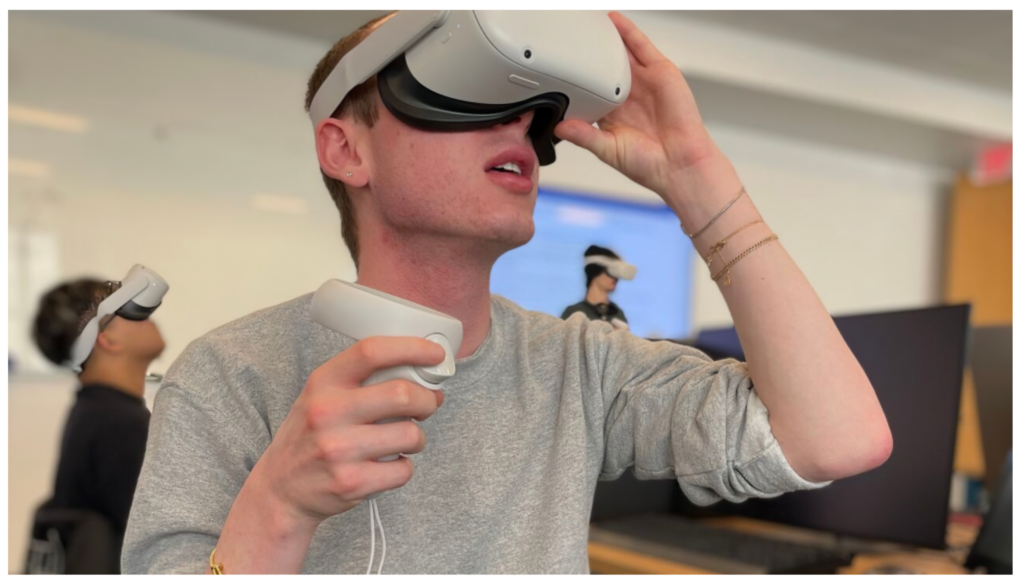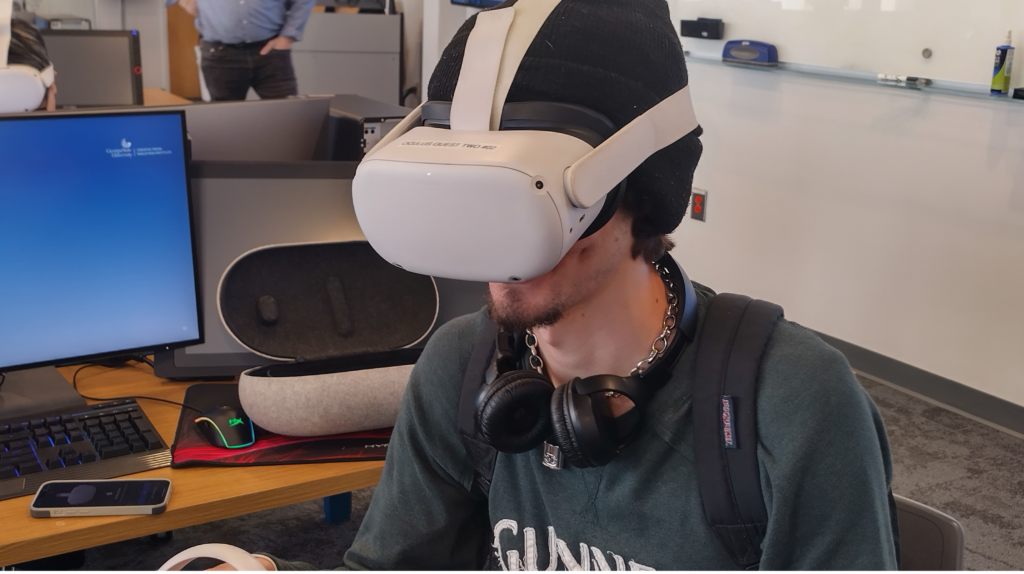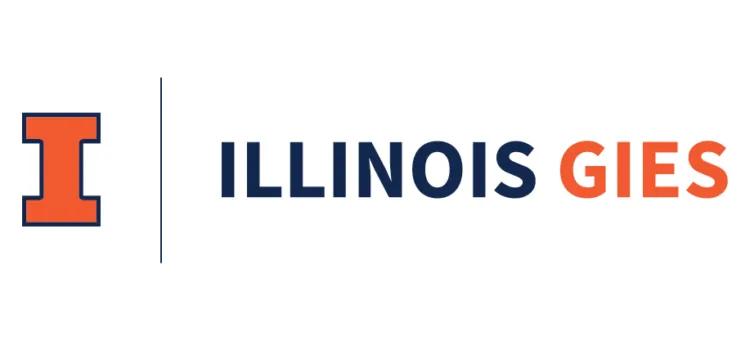
A student in Evaristo Doria’s course, “Doing Business in World Regions: Europe,” takes a VR tour of European destinations. Courtesy photo
When learning about the complexity of supply chain segments passing through the Panama Canal, you could read some case studies or maybe a chapter from a textbook. Your professor may present a lecture and lead you through a class discussion. Depending on your school, the course, and your own personal circumstance, you might even travel to Panama at some point to put into context what you – hopefully – still remember.
But, if you’re a student in Evaristo Doria’s undergraduate international business course, there’s no need to wait. After a short lecture and discussion, you can tour the canal immediately, without ever leaving the classroom.
For the price of a 360-degree camera (about $200) and some labor costs, Doria hired students to film virtual reality footage of the canal for a course at Georgia State University’s Robinson College of Business. Through VR headsets, students see for themselves examples from Doria’s lectures up close and personal.
“In terms of future potential, I think VR is limited mainly by the creativity of the instructor,” Doria tells Poets&Quants.
VR AFTER COVID-19
During the pandemic, business schools and professors started playing around with VR out of necessity. When travel restrictions grounded Vijay Govindarajan’s Global Insight Expeditions course at Dartmouth College Tuck School of Business, he used VR to show his second-year MBA students health and wellness problems affecting poor Indian families.
Now that travel restrictions have ended, professors continue to experiment. At University of Illinois’ Gies College of Business, professor Angel Chatterton uses VR to take students through an Airbnb so her tax students can learn the proper tax implications for its furniture and appliances. Emory University’s Goizueta Business School faculty leverage both VR and augmented reality to immerse students in lessons around crisis leadership, negotiations, and ethical dilemmas.

Evaristo Doria
And, in February, Berlin’s Tomorrow University of Applied Sciences launched an entirely VR version of its flagship Impact MBA in Sustainability, Leadership and Business Innovation. The launch came just a week after the release of Apple’s Vision Pro headset.
Doria, a senior lecturer at Robinson who teaches international business, has embedded VR into two of his courses: “Management in Central America: Panama and Costa Rica” and “Doing Business in World Regions: Europe.”
“There are so many countries, so many cities in Europe. To increase memorization and learning, I would like students to see these cities,” says Doria, who worked in more than 20 countries as an executive at companies such as Colgate-Palmolive and Johnson & Johnson before joining the Robinson faculty in 2006.
“Now, it’s very easy, with all the VR material, to have students visit Madrid, Barcelona, Belgium. The students never forget the places they visit virtually.”
‘TECHNOLOGY IS THE REAL DRIVER OF SOCIAL CHANGE’
Georgia State is investing in VR; its Creative Media Industries Institute helps develop VR experiences for educators from all departments. Doria was one of 15 professors to complete institute training on incorporating the tech in their courses.
“I love technology. I come from the area of organizational development, that’s what my doctorate is in, and I think technology is the real driver of social change,” he says.
His interest in VR piqued after reading an article about how Volvo was using it for innovation, product development, and to connect team members from around the world. He reached out to Timmy Ghiurau, the lead of the XR and Simulation Experiences Unit at Volvo Cars in Sweden, and realized how quickly businesses are incorporating VR into their operations.
Soon after, he read “Reality Check,” and got in touch with its author, Jeremy Dalton, head of immersive technologies at PwC. When Doria launched his first VR study abroad course during the pandemic, Dalton was a virtual guest speaker.
Today, Doria uses VR in two ways, though he is exploring even more applications. First, he uses it for immersive experiences like a walk along the Panama Canal or to a company headquarters in Europe. Second, to create team working opportunities inside virtual offices like you might see at a company with remote teams.

In the image, participants are immersed in one of Arthur Technologies’ specialized virtual workspaces, meticulously designed to facilitate seamless collaboration in VR. Courtesy photo
Doria partners with Arthur Technologies in Germany – a company with 30 versatile VR workspaces – for these courses.Arthur’s platform creates avatars based on a photo of student faces, so they are recognizable in virtual spaces. As opposed to a Zoom classroom where students can easily disengage by turning off the camera to deal with distractions, it’s much harder not to participate in the virtual auditorium. With the virtual meeting space, he can invite guest speakers from all over the world.
He lectures for about 20 minutes, and includes clues for answers students need to find in the VR environment. It forces the students to move around and interact with the experience.
“The level of engagement is very high,” he says.
BARRIERS TO VR CLASSROOMS
Of course, barriers still exist to a truly immersive VR classroom, despite the level of interest and innovation from both business and business schools.
First, VR headsets are still quite heavy and awkward. You can have moments of immersion, but you’re not going to fully escape to the streets of, say, San Jose, Costa Rica.
Headsets are also still expensive – for individual students and when you’re trying to equip an entire classroom. After Doria reached out, Arthur Technologies provided enough headsets for Doria’s classes, but that’s not necessarily possible for every program. It also limits the number of students in the class.
Similarly, you need engaging VR assets to make the classroom experience relevant. Otherwise, you’re really just using a high-tech gimmick. Youtube has a growing library of VR content, but it’s not necessarily tailored to a particular lesson.
That said, creating VR content is becoming relatively inexpensive. Doria plans to hire more students to tour more places with 360-degree cameras to augment his lessons.
VR should not be viewed as a replacement for international travel.
Georgia State University serves students from every background, some who have never before left Atlanta or Georgia, Doria says. For those business students, there’s no substitute for getting out into the world and seeing how business is done with their own eyes, ears, and feet.
Rather, VR should be viewed as an enhancement to travel experience. Doria still takes students every year to Panama, Costa Rica, and other parts of the world. Of course, not every student can afford an international immersion, either because of money, or schedules, or other life circumstances.
“I think virtual reality is opening up the possibility for more immersive, engaged learning in an age where we need to find ways of increasing the attention of students,” Doria says.

An international business student engages in virtual tour for Dario’s class, “Doing Business in World Regions: Europe.” Courtesy photo
PREPARING FOR THE FUTURE OF WORK
Integrating VR into business education is more than just keeping up with the technological Joneses. It’s about improving how students learn and engage with the world. It’s about preparing students for workplaces where virtual and augmented realities are already commonplace.
To weave VR lessons into curricula, professors first need a commitment to innovation, Doria says.
“Leadership needs to say that there is space for you to innovate, there is space to commit mistakes, there is space to try and fail because, in the beginning, it’s all trial and error.”
After that, schools will need to invest in the tech – both in the physical hardware and the software – while also creating the incentive structure for professors to create VR courses that actually enhance learning.
“You see companies like Apple and Meta putting tons of money in virtual reality, and they are all trying to find ways of making it more popular and a better experience. I think all the leaders in technology know that it has huge potential,” Doria says.
“Business schools need to prepare students for the future. That’s our role. So, I think, yes, every business school should train students in some way in virtual reality.”
DON’T MISS: THE ETHICS OF RESPONSIBLE AI: INSIDE THE NEW COURSE AT BERKELEY HAAS AND NYU STERN’S NEW SENIOR CAPSTONE: EXPERIENTIAL LEARNING AT SCALE










